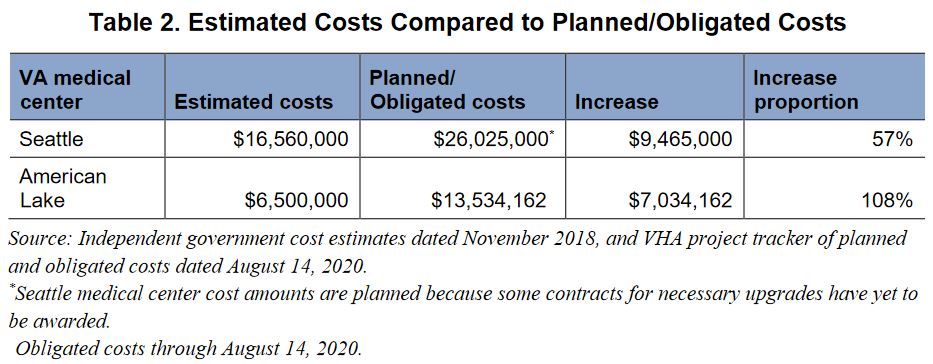
VA’s three initial operating capability sites are the Seattle, American Lake, and Mann-Grandstaff VA medical centers in Washington State. These were the first sites expected to deploy the new system prior to deployment schedule changes due to the COVID-19 pandemic. The Mann-Grandstaff VA Medical Center deployed the new system on Oct. 24, 2020.
WASHINGTON — VA might have underestimated the physical infrastructure costs related to its electronic health record modernization effort by billions, according to a VA Inspector General report analyzing the project costs.
The inspectors also found that VA’s Office of Electronic Health Record Modernization (OEHRM) did not include critical physical infrastructure upgrade costs in the program’s cost estimate reported to Congress. The revelation has angered legislators and left them wondering what other hidden costs the project holds.
When VA awarded the EHRM contract to Cerner in May 2018, it reported a total life cycle cost estimate (LCCE) of $16 billion. Three years into the endeavor, that estimate has remained unchanged.
In February 2020, however, VA revealed that billions in additional funding would be necessary to provide physical upgrades to things such as electrics and cabling, as well as heating, cooling and ventilation. This funding, VA said, was separate and distinct from the $16 billion LCCE.
As detailed in their report, IG investigators disagreed. Physical infrastructure upgrades—without which the EHRM program could not be implemented—should have been included in the estimate reported to Congress, they declared. By not doing so, VA presented legislators with an unclear picture of the program’s total cost.
As for why VA did not include the physical infrastructure costs in its $16 billion LCCE, according to the IG report, OEHRM officials did not consider physical infrastructure upgrades to be their responsibility.
“In fact, the only infrastructure costs the life cycle cost estimate included were related to information technology infrastructure,” the report states. “OEHRM officials stated that physical infrastructure upgrades were the responsibility of VHA. Accordingly, OEHRM stated it did not disclose these to Congress … because funding and completion of these upgrades were outside OEHRM’s responsibility and because these upgrades within VHA facilities had been long-standing.”
The report’s authors concede that long-standing deferred maintenance has likely contributed to the need for physical infrastructure upgrades. Yet, the inspectors found that these upgrades are necessary for the successful implementation of the new system and that the associated costs should have been disclosed to Congress before the contract with Cerner was signed.
As of January 2021, VA has provided Congress with eight mandated quarterly reports on the project’s costs. The physical upgrade costs were omitted from all of them.
“This left the program’s publicly reported LCCE significantly understated, leaving VA, the veteran community, and the congressional oversight committee without a comprehensive picture of total program costs,” investigators declared.
Estimates Vary Wildly
Just how much these upgrades will add to the $16 billion total is unknown. Over the past three years, VA’s estimates have varied wildly. In June 2019, a VA estimate put the cost of physical upgrades at around $2.6 billion. A second estimate that arrived in November 2019 put the cost at only $1.1 billion. A draft estimate created in June 2020 and has yet to be finalized raised the cost to $3.1 billion.
The extreme variations in the estimates suggested to IG investigators that the estimates, and perhaps VA’s methods, were unreliable.
In examining the first two estimates, IG investigators discovered a number of project-related costs had been mistakenly omitted. They also found that VA did not provide critical documentation supporting how the department came up with those final figures.
For example, both of the 2019 estimates included $458 million in fiber optic cabling costs—a figure that VA officials said came from estimates for the Seattle and American Lake VA Medical Centers. But VA staff were unable to show the process by which they reached that amount.
According to the report, the June 2020 estimate putting the cost at $3.1 billion is likely closest and is in line with the IG’s low-end projections.
One of the reasons for the variance in estimates is that the department did not begin to even consider the project’s nationwide physical infrastructure needs until after the contract with Cerner was signed in May 2018.
“VHA staff stated that they were not made aware that physical infrastructure upgrades were needed to support the system until November 2018 when they were notified by engineers at the Seattle VA Medical Center,” the report states.
This revelation came five months after VA had verbally informed Congress of the $16 billion estimated cost of the program.
It was not until September 2019 that VA created the group of subject-matter experts responsible for identifying physical infrastructure deficiencies related to the EHRM program, and a leader for the group was not hired until March 2020. The report notes that this timeline means that the group was not really in place until after the two 2019 estimates and that their input might be why the June 2020 estimate of $3.1 billion is so much higher.
Testifying before the House VA Committee, Bret Simms, director of VA’s Office of Asset and Enterprise Management was asked, if the VA had yet to do a thorough review of facilities to determine what infrastructure deficiencies actually existed. His answer was that the department has not.
“Some of the cost estimates for the physical infrastructure component related to OEHRM were done off of a ballpark figure initially, and, while it was refined, it wasn’t necessarily done via assessment to get more specific and reliable costs,” Simms said. “It’s pretty clear in this case that we’ve got some work to do.”
Simms would not say when he expected a reliable estimate to be available.

